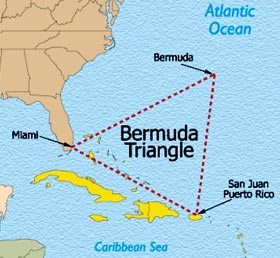The Bermuda Triangle
The Bermuda Triangle

The Bermuda Triangle is a stretch of the Atlantic Ocean bordered by a line from Florida to the islands of Bermuda, to Puerto Rico and then back to Florida. It is one of the biggest mysteries of our time - that isn't really a mystery.
The term 'Bermuda Triangle' was first used in an article written by Vincent H. Gaddis for Argosy magazine in 1964. In the article Gaddis claimed that in this strange sea a number of ships and planes had disappeared without explanation. Gaddis wasn't the first one to come to this conclusion, either. As early as 1952 George X. Sands, in a report in Fate magazine, noted what seemed like an unusually large number of strange accidents in that region.
What is the truth?
The mystery was more hype than reality. In 1975 a librarian at Arizona State University, named Larry Kusche, decided to investigate the claims made by these articles and books. What he found he published in his own book entitled The Bermuda Triangle Mystery-Solved. Kusche had carefully dug into records other writers had neglected. He found that many of the strange accidents were not so strange after all. Often a triangle writer had noted a ship or plane had disappeared in "calms seas" when the record showed a raging storm had been in progress. Others said ships had "mysteriously vanished" when their remains had actually been found and the cause of their sinking explained.
More significantly a check of Lloyd's of London's accident records by the editor of Fate in 1975 showed that the triangle was a no more dangerous part of the ocean than any other. U.S. Coast Guard records confirmed this and since that time no good arguments have ever been made to refute those statistics. So the Bermuda Triangle mystery disappeared, in the same way many of its supposed victims had vanished.
Even though the Bermuda Triangle isn't a true mystery, this region of the sea certainly has had its share of marine tragedy. Perhaps the best known one was the story of Flight 19.
The story of Flight 19

On a clear day five Navy Avengers of flight 19 took off for a routine mission. The experienced crew had a route that would take them 160 miles east, 40 miles north and the 120 miles straight back to base. The planes were suppose to carry three man crews, but one crew member failed to show. Perhaps it was just coincidence, or was it premonition? The planes had done their required preflight test and every thing checked out in good working order. It was a routine two hour mission but the planes were still fully fueled. The planes had extensive radio equipment to include ten different radio channels and homing devices that would show them the way home.
The first message that came from the patrol came in at 15:45: "Control tower this is an emergency. We seem to be off course. We seem to be lost. We can't make out where we are." The tower said "Head due west", but the flight did not know which way west was. "Everything looks wrong, even the ocean looks strange". The tower was puzzled; even if the compasses were not working, the crew should have been able to fly west by following the sun (which was several hours from setting). Finally around 16:25, the flight leader announced "We're not certain where we are. We must be 225 north-east of base... it looks like we are..." and then silence.
A Martin Mariner flight-boat with a crew of 13 took off to look for Flight 19. The Mariner sent several routine messages back to base before it, too, disappeared in the region where Flight 19 was thought to be. At 19:04, the last message from Flight 19 was received at base. It was only a faint message which repeated the letters "FT FT" , the call letters of Flight 19. The search for the planes continued for weeks, and even today the U.S. Navy has a standing order for crews to keep a look out for Flight 19. The military experts were completely baffled - how could 27 men and six planes just disappear? If the Avengers had run out of fuel, the planes would have floated long enough for the crews to get out and onto their rafts. The men were well-trained in sea survival. The official Navy report stated that the planes had vanished "as if they had flown to Mars".